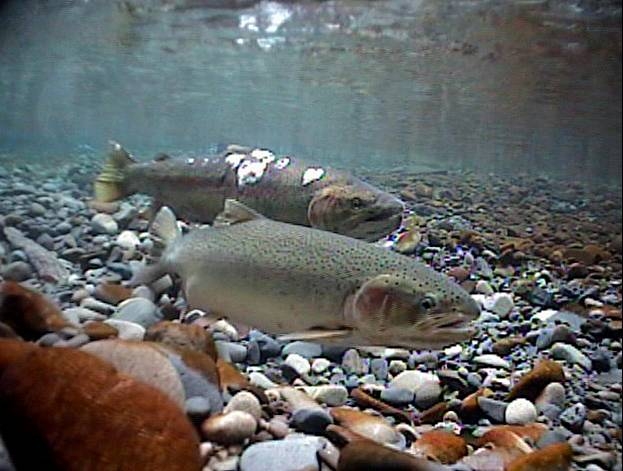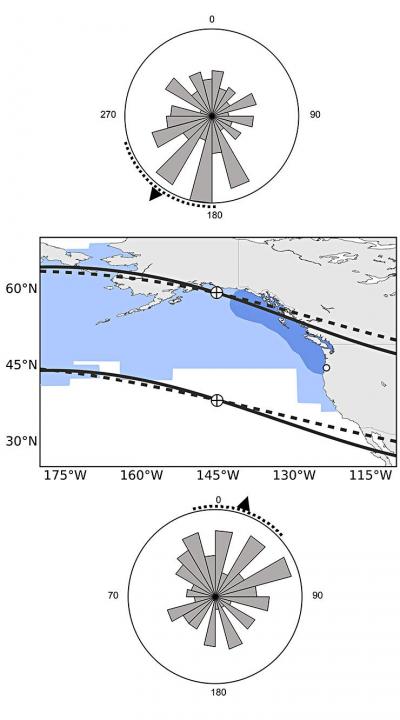Iron and steel in hatcheries, including rebar supporting concrete structural elements, could be distorting the ability of salmon and trout to navigate using the earth’s magnetic fields according to a study released today by Oregon State University.
The exposure to iron and steel distorts the magnetic field around the young fish, affecting the fish’s “map sense” and their ability to navigate, said Nathan Putman, who led the study while working as a postdoctoral researcher in the Oregon Department of Fisheries and Wildlife, part of OSU’s College of Agricultural Sciences.
For decades, scientists have studied how salmon find their way across vast stretches of ocean.

In a study last year, Putman and other researchers presented evidence of a correlation between the oceanic migration patterns of salmon and drift of the Earth’s magnetic field. They confirmed the ability of salmon to navigate using the magnetic field in experiments at the Oregon Hatchery Research Center.
That earlier research confirmed that fish possess a map sense, determining where they are and which way to swim based on the magnetic fields they encounter.
“The better fish navigate, the higher their survival rate,” said Putman, who conducted the research at the Oregon Hatchery Research Center in the Alsea River basin last year. “When their magnetic field is altered, the fish get confused.”
Subtle differences in the magnetic environment within hatcheries could help explain why some hatchery fish do better than others when they are released into the wild, Putman said.
The study suggests that stabilizing the magnetic field by using alternative forms of hatchery construction may be one way to produce a better yield of fish, he said.
“It’s not a hopeless problem,” he said. “You can fix these kinds of things. Retrofitting hatcheries with non-magnetic materials might be worth doing if it leads to making better fish.”
The new findings follow the earlier research by Putman and others that confirmed the connection between salmon and the Earth’s magnetic field.
Researchers exposed hundreds of juvenile Chinook salmon to different magnetic fields that exist at the latitudinal extremes of their oceanic range.
Fish responded to these “simulated magnetic displacements” by swimming in the direction that would bring them toward the center of their marine feeding grounds.
Putman repeated that experiment with the steelhead trout and achieved similar results. He then expanded the research to determine if changes to the magnetic field in which fish were reared would affect their map sense. One group of fish was maintained in a fiberglass tank, while the other group was raised in a similar tank but in the vicinity of iron pipes and a concrete floor with steel rebar, which produced a sharp gradient of magnetic field intensity within the tank. Iron pipes and steel reinforced concrete are common in fish hatcheries.
The scientists monitored and photographed the juvenile steelhead, called parr, and tracked the direction in which they were swimming during simulated magnetic displacement experiments. The steelhead reared in a natural magnetic field adjusted their map sense and tended to swim in the same direction. But fish that were exposed to the iron pipes and steel-reinforced concrete failed to show the appropriate orientation and swam in random directions.
More research is needed to determine exactly what that means for the fish. The loss of their map sense could be temporary and they could recalibrate their magnetic sense after a period of time, Putman said. Alternatively, if there is a critical window in which the steelhead’s map sense is imprinted, and it is exposed to an altered magnetic field then, the fish could remain confused forever, he said.
“There is evidence in other animals, especially in birds, that either is possible,” said Putman, who now works for the National Oceanic and Atmospheric Administration. “We don’t know enough about fish yet to know which is which. We should be able to figure that out with some simple experiments.”

Putman’s findings were published this week in the journal Biology Letters. The research was funded by Oregon Sea Grant and the Oregon Department of Fish and Wildlife, with support from Oregon State University. Co-authors of the study are OSU’s David Noakes, senior scientist at the Oregon Hatchery Research Center, and Amanda Meinke of the Oregon Hatchery Research Center.
